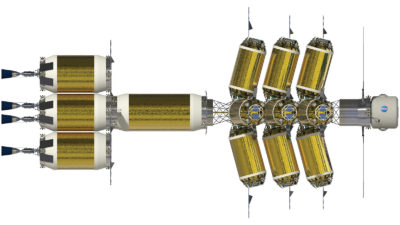Orion module undergoes acoustic testing
By D. Todd Griffith and Nathan Falkiewicz|December 2016
The Structural Dynamics Technical Committee focuses on the interactions among a host of forces on aircraft, rocket and spacecraft structures.
Research and development proved fruitful in 2016 in the disciplines of structural dynamics as evidenced by the work of industry, government and academic members of the AIAA Structural Dynamics Technical Committee.
Vibroacoustic testing was performed at NASA Glenn Research Center, Cleveland, on the Orion Multi-Purpose Crew Vehicle’s European Service Module Structural Test Article, or E-STA. The module provides Orion with propulsion, electric power, thermal control and fluid storage. The E-STA Acoustic Test Campaign occurred in the spring at the Reverberant Acoustic Test Facility at Glenn’s Plum Brook Station. Participants included the European Space Agency, Airbus, Dutch Space, Lockheed Martin and NASA.
Ten acoustic tests were performed on the E-STA over a three-week period. The primary conclusions from the test were: The solar array wing was successfully mechanically test qualified; both ESA and Airbus along with NASA agreed that the E-STA test article was in a good structural health; and all organizations agreed that the E-STA test campaign was successful relative to the objectives. Next, the E-STA hardware was sine vibration tested at Plum Brook’s Mechanical Vibration Facility and plans were made for the Direct Field Acoustic Test at Plum Brook in early 2017.
ATA Engineering performed ground vibration tests to support development of novel, highly flexible sailplanes to support flight testing and stability analysis. The Perlan Project is an attempt to fly a sailplane up to 90,000 feet using only the energy of “mountain waves.” Perlan will be attempting this feat in its sailplane, the Perlan 2, before the year ends. With its 85-foot wingspan, the Perlan 2 is larger and more flexible than most gliders, introducing the potential for flutter. Perlan officials approached ATA to perform a predictive flutter analysis using a finite element model. Before the flutter analysis could begin, the model needed validating and this was accomplished through a ground vibration test of the airplane.
The test provided the data needed to correlate modal properties against the finite element model. Once satisfactory correlation was achieved, ATA performed the flutter analysis. The results will be used by Perlan to guide the flight testing program.
The University of Michigan’s Aerospace Engineering Department received a five-year grant from the Air Force Office of Scientific Research for the topic “Avian Inspired Morphing.” Its goals are to study gliding birds and extract methods for improving unmanned systems’ performance via active materials. The first year’s effort focused on trailing edge morphing and eliminating the vertical tail. Birds control yaw by shape-changing horizontal tail, which has been emulated with a macro fiber composite tail section capable of coupled bending and twisting. This is a multi-university effort led by Michigan that includes Stanford, UCLA, Texas A&M, the University of British Columbia and the Royal Veterinary College in London, with researchers spanning bird biology, materials engineering, controls, sensing and structural dynamics.
University of Maryland researchers performed a 3-D aeromechanical analysis of the Tilt Rotor Aeroacoustic Model, or TRAM, a one-fourth scale model of the V-22 proprotor. Next-generation rotorcraft analyses are envisioned to use integrated 3-D analysis, in which rotor structures are modeled using 3-D finite element analysis. Developed by the U.S. Army’s Aeroflightdynamics Directorate, X3D is a 3-D rotor multibody computational structural dynamics analysis tool designed to be coupled with Helios, the Army’s next-generation computational fluid dynamics framework.
In collaboration with the Aeroflightdynamics Directorate and NASA’ s Ames Research Center in California, the University of Maryland has been working toward detailed structural modeling of TRAM and validating X3D predictions. Coupling X3D structural dynamics with Helios aerodynamics resulted in excellent correlation between predictions and experimentally measured dynamic airloads in the loads critical conversion corridor and revealed complex dynamic stress/strain patterns on the rotor blade and hub.
Based on the success of this pilot project — the first integrated 3-D analysis of a real rotor system — the University of Maryland received a five-year grant from the Army to develop new methods and algorithms toward exascale simulation of aeromechanics. ★



































